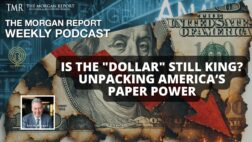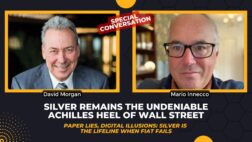In previous missives, I have addressed the theoretical price of gold in U.S. dollar terms. This is a straightforward calculation based upon the M1 currency supply and the amount of gold the Treasury of the United States claims it owns.
Naturally, putting your neck out for a gold price leads to the next logical question and that is, “What price will silver reach at its high point?” This question is much more difficult to answer, because silver is not considered to be money in any government’s monetary base, either officially or unofficially.
Let me digress here for a moment. Many central banks worldwide still own gold. Yes, most have sold gold for paper the past several years, but they do consider it to be a monetary asset nonetheless. Additionally, some governments are actually increasing their gold holdings, so it is factually correct to place gold into the monetary aggregate base.
This is not true of silver; both the Chinese and Indian governments hold pitifully small amounts of silver in inventory, but for all practical purposes, all governmental silver holdings are depleted. Yet silver has been used as money more often, in more places, and for longer periods of time than even gold. This is difficult for most Western readers to absorb, yet as Milton Friedman said in 1993,
“The major monetary metal in history is silver, not gold.”
Coming back to forecasting the price of silver, we need to define a methodology. One way is to use what I call the classic, or monetary, ratio. This is based upon a bimetallic standard, which was exercised when both gold and silver were used daily as money. The ratio was fixed between 15-16 to 1. In other words, one ounce of gold bought 16 ounces of silver. If we use our gold price of $3400 derived in last week’s column, and divide by 16, that puts silver at $212.50 per ounce.
Before moving on let me clarify something—the ratio on hit 16 to 1 for one day, in the last bull market! It was the highest price silver has ever been in history! So, do I expect silver to outperform gold?—Yes! Will the 16 to 1 ratio be achieved? Most likely –Yes! BUT and this is a big BUT, it will happen most likely on a spike and near the end of the bull market in the precious metals.
Is this possible? Under our current financial conditions I am reluctant to rule out anything, but I am also a practical investor. Before we ever get to even $100, which I have forecast as a price I do expect silver to achieve, we must move above $30, then $40, and take out the old nominal high of $50. I think you see my point, and the ultimate high price is impossible to determine, because only the market knows. But in my view, silver has way too many things going for it not to continue higher over the next several years.
Consider the following points:
- Silver has every monetary attribute of gold and is far more affordable to the general public
- Monetary worry was primarily U.S.-based in 1980; today it is a worldwide concern
- The U.S. was in far stronger financial condition in 1980 than today
- The Silver ETF did not exist in 1980
- Silver is a much smaller market than gold, and therefore any new buying (or selling) has much more effect on the price
- In 1980, silver hit $50 per ounce when there were at least two billion ounces of silver in bullion form; today there is less than one-fourth that amount.
David Morgan
Mr. Morgan has followed the silver and gold market daily for over thirty years. Much of this Web site, www.silver-investor.com, is devoted to education about the precious metals.
You can get his Ten Rules of Silver Investing — click here



